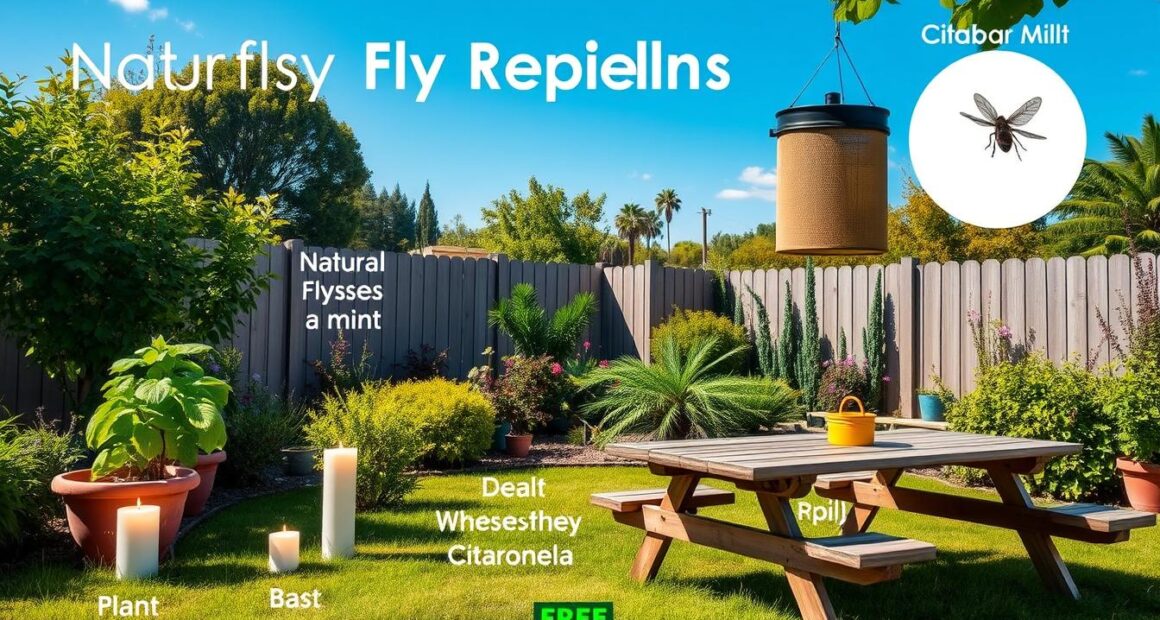Imagine a calm evening in your yard. The sun is setting, and there’s laughter everywhere. But, you hear constant buzzing. This noise is ruining the moment. Flies are invaders in your outdoor space from spring to fall. Figuring out how to keep them away means more fun at outdoor events.
Flies are more than just bothersome. They can bring diseases like cholera and salmonella. It’s crucial to know the best methods for getting rid of flies outside. This guide will cover effective ways to control flies, remove them, and prevent them. Together, we’ll make sure our outdoor spaces are fly-free. We want every outdoor moment to be as perfect as it should be.
Key Takeaways
- Flies thrive in warmer weather, especially from spring to fall.
- Effective outdoor fly control is crucial to maintain a pleasant environment.
- Flies can spread serious diseases; controlling their presence is vital.
- Simple cleaning practices can significantly reduce fly attraction.
- Natural repellents and traps are effective and environmentally friendly options.
Understanding the Fly Problem
Flies are a big challenge outdoors, with over 16,000 species in North America. Understanding them is key to dealing with their rapid population growth. The problem worsens when fly infestation occurs. It disturbs outdoor fun and poses health risks.
Spotting small spots or swarms near food and waste signals fly issues outdoors. This means they’re breeding nearby, often in garbage or pet waste areas. A single female can lay up to 900 eggs. Under the right conditions, these eggs hatch in 12 to 24 hours.
Flies are not just annoying. They carry harmful bacteria, contaminating food and risking health. The U.S. Department of Agriculture says flies damage $10 billion in agricultural products yearly. Knowing about flies helps in finding ways to control them.
To keep outdoors clean and enjoyable, address fly infestation quickly. Understanding where they feed and breed can greatly reduce their numbers. This makes outdoor spaces better for everyone.
Common Types of Flies Found Outside
When you explore outside, you’ll meet different common flies. Knowing the types helps control them and makes being outside more pleasant.
Houseflies (Musca domestica) are very common. They look dull gray and are about 1/4-inch long. They love places with lots of organic waste, like leftover food or animal poop. This helps them multiply quickly.
The cluster fly (Pollenia rudis) is something to watch for too. They are bigger than houseflies, with a unique checkered body, nearly 1/2-inch big. They like to hang out together near windows or lights when it’s warm.
Then there are fruit flies (Drosophila melanogaster). These tiny bugs, around 1/8-inch long, have a yellowish-tan body and clear gray wings. They are attracted to ripe or rotting fruit. You’ll see them in gardens and places where food is prepared outside.
Here’s a quick overview of these fly types:
| Type of Fly | Scientific Name | Size | Common Locations |
|---|---|---|---|
| Housefly | Musca domestica | 1/4 inch | Near organic waste |
| Cluster Fly | Pollenia rudis | 1/2 inch | Windows, light sources |
| Fruit Fly | Drosophila melanogaster | 1/8 inch | Gardens, outdoor kitchens |

What Attracts Flies to Your Outdoor Space
Knowing what attracts flies to outdoor areas is key for keeping them away. Food, water, and breeding spots are their main targets. Flies love food, especially grilled meats and sweets during picnics.
Things like pet waste, rotting stuff, and open trash also draw them in. These give off smells that flies can’t resist. To keep flies at bay, clean your bins regularly and keep them closed.
Moisture is another big attractor for flies. They breed in standing water. To stop them, get rid of any water collections. Check your gutters and plant pots to make sure they’re dry.
To make outdoors less inviting to flies, try these:
- Keep food covered and clean up immediately after meals.
- Clean pet waste regularly to minimize strong odors.
- Avoid leaving standing water in flower pots or containers.
- Seal compost bins tightly to prevent any exposure to food waste.
- Opt for landscaping that minimizes debris and tall grasses, which can harbor breeding populations.

Effective Ways to Remove Food Sources
To manage flies, taking action early is key, especially regarding their food sources. Several steps can ensure your outdoor areas stay free of flies. Keeping areas clean and storing things properly cuts down the risk of attracting flies.
Cleaning Trash Bins Regularly
Clean trash bins are a must. Washing them often helps get rid of smells that bring flies. Clean them well every week. Using strong lids that seal well keeps those enticing smells locked away.
Using Sealed Food Containers
Airtight containers are your best bet for storing food. They keep flies away from your food. Always cover food, especially sweets, to make them less appealing to flies.
Managing Pet Waste
Cleaning up after pets regularly is crucial for keeping flies at bay. Pet waste attracts flies and is a perfect breeding place for their larvae. Quick cleanup and proper disposal reduce breeding sites and help keep your area fly-free.

Best Way to Get Rid of Flies Outside
To effectively control flies outside, focus on their breeding sites. Getting rid of places that attract flies reduces their numbers. Look at areas where flies commonly start their lifecycle for management and prevention.
Removing Breeding Grounds
Fly breeding sites often include areas with decaying organic materials. To limit these breeding spots:
- Regularly clean up pet waste to eliminate high moisture content that attracts flies.
- Dispose of food scraps and trash quickly, emphasizing cleanliness in garbage cans.
- Avoid overwatering plants, as standing water can become an ideal breeding ground.
- Keep compost piles well-aerated and covered to deter flies from laying eggs.
Identifying Common Fly Infestation Sources
Knowing where flies commonly breed helps in creating effective control plans. Watch out for these frequent sources:
| Infestation Source | Details | Control Method |
|---|---|---|
| Trash Bins | Flies are attracted to decomposing waste. | Clean with bleach solution and keep lids sealed. |
| Compost Piles | Organic matter provides ideal breeding conditions. | Cover and aerate regularly. |
| Standing Water | Stagnant water allows breeding of certain fly species. | Eliminate any stagnant water and manage drainage effectively. |
| Pets and Livestock Areas | High moisture content from waste can attract flies. | Implement frequent waste removal routines. |

Prioritize cleanliness and closely watch fly breeding areas to better control flies outside. This approach not only decreases current fly populations but also helps prevent new infestations.
Natural and DIY Remedies for Fly Control
Controlling flies in your outdoor spaces doesn’t have to harm the environment. Using natural and DIY methods can greatly lessen the number of flies. Here are some effective strategies to try out.
Fly-repelling Plants
Adding fly-repelling plants to your garden is both pretty and useful. They can make your space look better and keep flies away. Some great plant choices include:
- Basil: Flies dislike its strong smell.
- Lemongrass: Its pleasant scent wards off flies.
- Mint: Its fresh aroma repels various fly species.
- Lavender: Besides smelling good, it also deters flies.
Essential Oil Solutions
Essential oils are a great way to fight off flies naturally. Mixing oils like eucalyptus, citronella, and clove makes a potent repellent. Try this simple recipe:
- 1 tablespoon of vinegar
- 1 tablespoon of baking soda
- 1 cup of water
Spray this mixture around your outdoor spaces to keep flies away. Adding apple cider vinegar to traps can also attract and catch flies with dish soap.

Setting Up Traps to Catch Flies
Setting up effective traps is key to managing fly populations outdoors. The DIY apple cider vinegar trap is simple and works well. For bigger problems, commercial traps are great. Knowing how to use both types can really help control flies.
How to Make an Apple Cider Vinegar Trap
Making an apple cider vinegar trap is cheap and easy. First, gather these items:
- 1/4 cup of apple cider vinegar
- 1-2 drops of liquid dish soap
- A bowl or jar
Mix the vinegar and soap in a container. The soap makes flies fall in, not just land. Place it where you see the most flies. It’s great for fruit flies, catching hundreds in days.
Using Commercial Fly Traps
For big areas or lots of flies, use commercial traps. Options like Catchmaster’s traps work well by catching flies with color and pheromones. They’re best for places with lots of flies.
Choose a commercial trap that fits your needs. Catchmaster’s Yellow AG Roll is good for large outdoor areas. Some traps use UV light to attract flies. Keep traps maintained for the best results.

Using Repellents to Deter Flies
Using fly repellents can make your outdoor areas less fly-friendly. You can try candles, essential oils, and fans to keep flies away. It’s easy to incorporate these into your outdoor setting.
Candles and Essential Oils
Citronella candles are well-known for keeping flies away. They give off a scent that flies don’t like. While burning, they make your outdoor space comfy for you but not for flies. For the best results, use several candles at once, especially if you’re hosting an outdoor event.
Setting Up an Oscillating Fan
An outdoor oscillating fan is a great choice to deter flies. The breeze messes with their flying, making it hard for them to land. This not only cools you down on hot days but also keeps flies away during outdoor meals or while chilling on your deck.

| Method | Effectiveness | Notes |
|---|---|---|
| Candles | Moderate | Best in small areas; requires multiple for larger spaces. |
| Essential Oils | Variable | Specific oils may repel flies; anecdotal evidence available. |
| Outdoor Oscillating Fan | High | Creates a breeze that disrupts flies’ navigation ability. |
Utilizing Natural Predators
Maintaining a balanced ecosystem is key to controlling flies. Natural predators play a vital part in managing fly populations. They help balance nature outside, making it hard for flies to thrive.
By supporting wildlife, you can build an area that keeps flies away. This approach is nature-friendly and effective.
Encouraging Birds and Bats
Adding birdhouses and bat shelters attracts these helpful animals to your space. Birds and bats eat many insects, flies included. This lowers the number of flies around.
Creating a welcoming space for them helps control flies. It also makes your garden more diverse in life.
Welcoming Amphibians
Frogs and toads are great at fighting flies. They like damp places and eat both flies and their larvae.
Inviting these amphibians to your yard adds a natural fly control layer. It’s a smart move for ecological fly management.

| Natural Predator | Diet | Benefits |
|---|---|---|
| Birds | Insects, including flies | Reduce fly populations, promote biodiversity |
| Bats | Insects, including flies | Nightly pest control, reduce chemical use |
| Frogs | Insects, larvae | Control fly larvae and adult populations |
| Toads | Insects, including flies | Actively hunt flies, add to garden ecosystem |
Preventive Measures for Long-term Fly Control
Putting preventive measures in place is key for lasting fly control. By keeping outdoor areas clean and checking for signs of flies regularly, you can greatly cut down on their numbers. This creates a less appealing environment for flies to breed and makes outside spaces more enjoyable.
Maintaining Clean Outdoor Spaces
Effective outdoor maintenance begins with keeping the area clean. Get rid of anything that might attract flies, like rotting fruit or pet waste. Make sure trash bins are washed often and food is kept in sealed containers. This approach makes your space nicer and stops flies from getting comfortable. Additionally, regular upkeep of your outdoor space includes inspecting structures for signs of wear or damage, such as roofs that may require attention over time. If you’re wondering how often do roofs need reshingling, it’s typically recommended to do so every 20 to 30 years, depending on the material used and local weather conditions. By maintaining your property and addressing these needs proactively, you can create a more pleasant environment while preventing potential infestations.
Regular Inspection and Maintenance
Inspect your outdoor spaces routinely for possible fly breeding sites, like still water or too much clutter. Act quickly if you see signs of flies. Paying attention to your property regularly is vital for combating flies over time. It lets you handle issues before they turn into bigger problems.

When to Call a Pest Control Professional
When home remedies fail and the fly numbers keep growing, it’s time to call in the experts. Wondering when to bring in pest control professionals? If you’re constantly swatting away new flies, it’s a sign of a big problem that needs expert help.
These fly solution experts find where flies breed and develop unique strategies for your situation. They know all about flies, like face flies and deer flies. This helps them stop the infestation.
Professionals use Integrated Pest Management (IPM) to kill flies in an eco-friendly way. With programs like Schendel Pest Services Premium Care, you get visits every quarter. This keeps flies away by considering the local climate.
In Florida, the warm climate helps flies breed fast, so it’s crucial to act early. Flies can land on and contaminate surfaces, posing health risks. They can spread over 65 diseases, making professional help vital.
Here are signs that you need pest control:
- Persistent flies, even after trying to get rid of them yourself
- The number of flies is quickly growing
- Places where flies breed are found inside or outside
- Concerns about diseases from flies

Potential Health Risks Associated with Flies
Flies pose real health risks from flies by spreading many diseases. They carry fly-borne diseases like cholera, salmonella, and typhoid fever. It’s crucial to take steps to prevent these diseases.
House flies are especially worrisome because they breed in dirty places. They lay eggs on animal waste or garbage, which is a big sanitation issue. These flies can fly up to 20 miles, spreading germs far and wide.
To fight these health risks, we need to know how flies behave and what they like. Keeping places clean is key, and we should:
- Keep trash cans closed and in good shape.
- Empty and clean dumpsters often.
- Store food in tight containers to keep flies out.
The house fly’s life cycle is very short; their eggs hatch in just 7½ hours if it’s warm enough. Since they reproduce so fast, controlling their numbers is critical. Adult house flies usually live about 2½ weeks in the heat, but can last up to three months in cooler weather.
It’s important to keep your area clean and watch for flies. Knowing how to manage flies helps stop health risks and keeps your space safe.

| Fly Type | Primary Breeding Sites | Health Risks |
|---|---|---|
| House Flies | Animal feces, garbage | Salmonella, cholera |
| Blow Flies | Decaying organic material | Potential contamination |
| Stable Flies | Animal feces | Painful bites (no disease transmission) |
| Fruit Flies | Fruits, sweet liquids | Food contamination |
| Drain Flies | Moist organic debris | Minor sanitation concerns |
Conclusion
To really enjoy the outdoors, you need to tackle the fly issue well. This summary tells us that keeping flies away can make being outside much nicer. By getting rid of food sources, using natural things that flies don’t like, and setting up good traps, we can control flies.
Also, keeping things clean and checking your outdoors regularly helps keep it free of flies. Flies like warm places, so make sure your home is tight to keep them out. A few small actions can make a big difference in enjoying the outdoors.
With some work and care, you can make your space comfy and free of annoying flies. Start using these tips now and turn your outside areas into places without flies!









